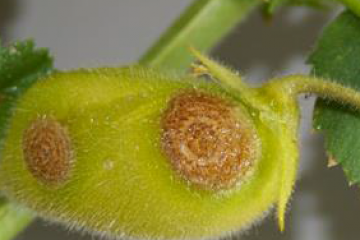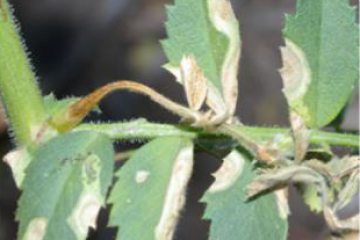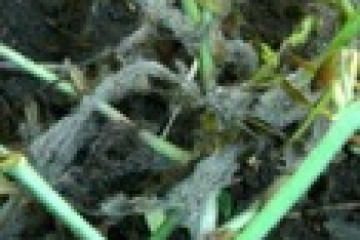Australian Pulse Bulletin
Chickpea fungicide guide: 2021 season
Foliar fungicides can help manage the chickpea diseases Ascochyta blight (AB) and Botrytis grey mould (BGM), but when to commence a fungicide program and how often to spray, depends on the varietal resistance, weather conditions and the potential yield of the crop. There is limited resistance to both AB and BGM and both diseases are very aggressive and can spread rapidly, so being proactive is imperative in disease control. Bear in mind that AB is endemic in paddocks that have a history of chickpea in many areas of Qld and NNSW; further because Ascochyta can spread on infected chickpea residue, paddocks that have never grown chickpeas can still be at risk if residue has arrived in such paddocks as dust out the back of headers or as stubble in surface water flows or high winds. BGM is a widespread disease of many crops in Qld and NNSW so crop rotations and cultural practices should be considered when growing chickpeas. Chickpea after chickpea can never be recommended as this creates a high risk of disease epidemic varietal resistance will be reduced or overcome.
Pulse Australia have Minor Use Permits from APVMA in place for 2021 to help growers with disease control and these are shown in the table below along with all the current registered products.
Fungal disease control is based on the use of integrated disease management to minimise the injury to crops from plant pathogens. Efficient use of foliar fungicides is based upon the protection of plants rather than curing existing infections. The first fungicide application must be applied as early as necessary to minimise the establishment of the disease especially in paddocks that have had a history of pulse crops. Current research shows that a fungicide application prior to rain events at the early vegetative stage will give protection from AB that can translate to yield increases or at least to maintaining expected yields. Additional fungicide applications are required if weather conditions favour the disease, but the best management recommendation for disease control remains that foliar fungicides should be applied prior to forecast rain to provide the greatest level of protection. Post-infection applications can be effective in low rainfall growing regions or seasons, but this practice does carry greater risk. Chlorothanonil and mancozeb are persistent and rain-fast, but do not prevent infection if applied after rain starts.
Fungicides remain effective on leaves that are given good coverage, but keep in mind that all new growth after spraying is unprotected. In winter, new leaves may take 5-7 days to grow, but in spring as conditions warm up this is reduced to 2-3 days. Timing of fungicide applications is critical. An application in advance of a rain front provides maximum protection. Delaying application until after a rain front reduces efficacy significantly, as rainfall will rapidly promote spread of inoculum. With high levels of inoculum in many paddocks, a protective fungicide application soon after crop emergence may be required. Close monitoring for early symptoms will give greater opportunities to minimise disease establishment and yield loss.
The need for repeated fungicide applications depends on the growth stage of the crop, the time since the last fungicide application and the likelihood of further conditions favouring disease development. Unprotected crops may be quickly defoliated and destroyed by the infection. Under favourable disease conditions, varieties that are susceptible to AB will require multiple sprays through the season, while varieties with moderate susceptibility to AB will require at least 3-4 sprays over the season.
The choice of fungicide is less important than the timing, but when multiple sprays are required during the season it is critical to rotate different products and modes of action to preserve the effectiveness of all the fungicide choices. Follow this link for advice on maintaining fungicide efficacy for the grain industry.
Seasonal Conditions in 2021
After a bumper season in 2020 that produced record yields in many areas of NSW, Victoria and South Australia, rainfall has been variable over summer in many regions. NSW and southern Queensland have had good rainfall over summer that has given full soil moisture profiles. Victoria and South Australia started with dry conditions for sowing winter crops but have recently received adequate rain to get crops germinated. In Western Australia conditions have been very favourable for sowing crops and regular rain events have followed. This season will be favourable for many diseases as we head into spring. Many of these diseases need only limited moisture to infect crops (heavy dew or fog may provide enough moisture), so monitoring needs to be continued through the different growth stages of the crop. With good access for ground sprayers this year, allowing for high water rates and canopy penetration, timely fungicide application will give the crop the best chance of a high yield.
For more detailed information on disease management:
- Chickpea: Integrated disease management
- CropPro chickpea crop disease manual
- Fungicide resistance in grain crops (including pulses)
-

Ascochyta blight on chickpea pod (G Cumming)
-

'Ghosting' caused by ascochyta blight on chickpea leaves (SARDI)
-

Botrytis grey mould (P Davis)
Fungicide Minor Use Permits for chickpea
- PER81406 Captan / Ascochyta blight, chocolate spot, grey mould / Current to 30-Sep-2023 (All States)
Fungicides registered for use on chickpea
| Chickpea Foliar Fungicide
|
Trade Name example
|
Ascochyta
|
Botrytis
|
WHP Harvest
|
|---|---|---|---|---|
| Chlorothalonil 720
|
CC Barrack 720
|
1.0–2.0 L/ha
|
NR
|
14 days
|
| Mancozeb 750
|
Dithane SC
|
1.0–2.2 L/ha
|
1.0–2.2 L/ha
|
28 days
|
| Mancozeb 420
|
Penncozeb SC
|
1.8–3.95 L/ha
|
NR
|
28 days
|
| Carbendazim (Group 1)
|
Spin Flo
|
NR
|
500 mL/ha
|
28 days
|
| Captan 900
|
CC Captan 900
|
Permit 1.1 kg/ha
|
Permit 1.1 kg/ha
|
14 days
|
| Captan 800
|
CC Captan 800
|
Permit 1.25 kg/ha
|
Permit 1.25 kg/ha
|
14 days
|
| Azoxystrobin (Group 11) 120 g/L and Tebuconazole (Group 3) 200 g/L
|
Veritas
|
0.75–1.0 L/ha
|
0.75–1.0 L/ha
|
28 days
|
| Metiram 700 (M3)
|
Polyram DF
|
1.0–2.2 kg/ha
|
1.0–2.2 kg/ha
|
42 days
|
| Bixafen (Group 7) + Prothioconazole (Group 3)
|
Aviator XPro
|
400–600 mL/ha
|
NR
|
35 days
|
Many of the Minor Use Permits have short term expiry dates (e.g. 30/11/2017)
NR = Not Registered for this disease
Read the LabelAs with any chemical application, care should be taken to observe all the label conditions for each product. Some label advice is different for each state or region, so for best results, it is important that this is followed. Many of our pulse crops are exported for human consumption, so market access is dependent on having the product free of chemical residues. Australian has a reputation for providing clean and safe produce so it is vital that this is maintained by using chemicals according to regulations. All permits have label recommendations for use rate and withholding periods (WHP) that must be observed so grain will comply with Maximum Residue Limits (MRL) allowable for market access. |
Key contacts
Pulse Australia Industry Development Managers
- Paul McIntosh
Phone: 0429 566 198 - Phil Bowden
Phone: 0427 201 946
Support and funding acknowledgement
Disclaimer
Information provided in this guide was correct at the time of the date shown below. No responsibility is accepted by Pulse Australia for any commercial outcomes from the use of information contained in this guide.
The information herein has been obtained from sources considered reliable but its accuracy and completeness cannot be guaranteed. No liability or responsibility is accepted for any errors or for any negligence, omissions in the contents, default or lack of care for any loss or damage whatsoever that may arise from actions based on any material contained in this publication.
Readers who act on this information do so at their own risk.
Copyright © 2015 Pulse Australia
All rights reserved. The information provided in the publication may not be reproduced in part or in full, in any form whatsoever, without the prior written consent of Pulse Australia. www.pulseaus.com.au
Last updated: 9 July 2021

